| List of pictures | Menu | Lijst met fotoseries |
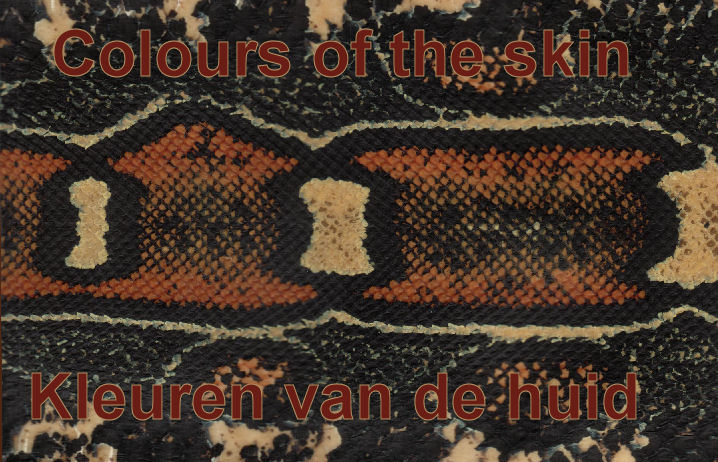 |
||
| 7. Colours of the skin of Boa constrictor |
All
pictures: / Alle foto's: © A.A. Verveen & E.M. Verveen-Keulemans |
7. Kleuren van de huid van Boa constrictor |
| The
skin is coloured at the outside since epiderm as well as the outer
dermal cell layer contains many pigment granules. The other dermal
cells do not contain pigments hence show the original colours of the
skin: a milky bluegrey (skin of a dead boa). |
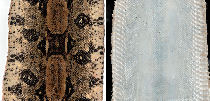 |
De
huid is aan de buitenkant gekleurd omdat zowel de opperhuid als de
buitenste cellaag van de leerhuid veel pigmentkorrels bevatten. Aan de
binnenkant niet, zodat daar de echte kleur van de huid is te zien: een
grijsblauwe melkkleur (huid van een dode boa). |
| The
skin consists of the upper layer or epidermis and the dermis. The
epidermis is rolled off from right to left (skin of a dead boa). |
De
huid bestaat uit twee lagen: de opperhuid, die van rechts naar links
wordt opgerold en de lederhuid (huid van een dode boa). |
|
| Removal of the epidermal skin off the skin of the head of a dead male boa exhibits the subtle play of dermal skin colours. | 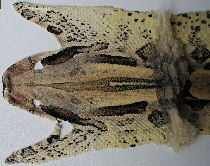 |
Bij het afrollen van de opperhuid van de kophuid van een dood mannetje wordt het subtiele kleurenspel van de lederhuid goed zichtbaar. |
| Outside view of the skin: left: complete skin, center: epidermis removed, right: corresponding epidermis only. |
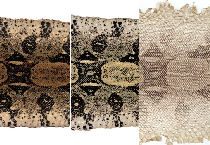 |
De buitenkant van de huid. Links compleet, midden: opperhuid verwijderd, rechts bijbehorende opperhuid. |
| Similar picture, detail. The dermis (centre) contains dark melanin, about black, while the epidermal melanin (right) is coloured a lichter brown, and is distributed in different densities. | 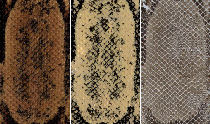 |
Idem, detail. Duidelijk is dat de lederhuid (midden) donker melanine bevat, haast zwart, terwijl in de opperhuid (rechts) lichter bruin melanine in verschillende dichtheden voorkomt. |
| Epidermal colours vary from dark reddish brown (top left) via light reddish brown (top right) to about translucent (bottom left). Bottom right: complete translucency. |
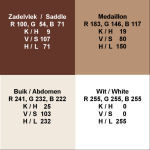 |
Kleuren van de opperhuid. De kleuren varieren van donker roodbruin (linksboven) via licht roodbruin (rechtsboven) tot praktisch geheel doorzichtig (linksonder). Rechtsonder: helemaal doorzichtig. |
| Red, orange (here), yellow, ochre and salmon coloured pigments are synthesized in plants only. Animals obtain the pigments by way of the food chain. |
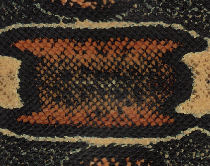 |
Rode, oranje (hier), gele,
oker en zalmkleurige pigmenten worden uitsluitend in planten
aangemaakt. Dieren krijgen ze alleen via de voedselketen binnen. |
| The
white pigments in the "eyes" on the flanks of the boa and around its tail are caused by
larger guanin crystals that reflect all the wavelengths of visible
light. Smaller crystals reflect blue only, which together with yellow
vegetable pigments creates the green colours of other reptiles and
amphibians. |
Het witte
pigment in de "ogen" op de flank en de ringen rond de staart bestaat uit grotere
guaninekristallen. Deze reflecteren licht van alle golflengten, dus wit. Kleinere kristallen reflecteren blauw dat samen met gele plantpigmenten door "pixelmenging" de kleur groen veroorzaakt die wij bij allerlei reptielen, en amfibiën kunnen zien. |
|
|
The melanin pigment is made in the animal itself. Black in the dermal skin at left, and different shades of brown in the corresponding epidermis at right. |
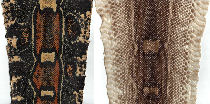 |
Het melanine wordt door het dier zelf aangemaakt. Zwart melanine in de lederhuid links, met verschillende intensiteiten bruin in de bijbehorende opperhuid rechts. |
| |
|
|
| Revised: December 25th, 2010 | ||
| List of pictures | Top / Naar boven | Lijst met fotoseries |